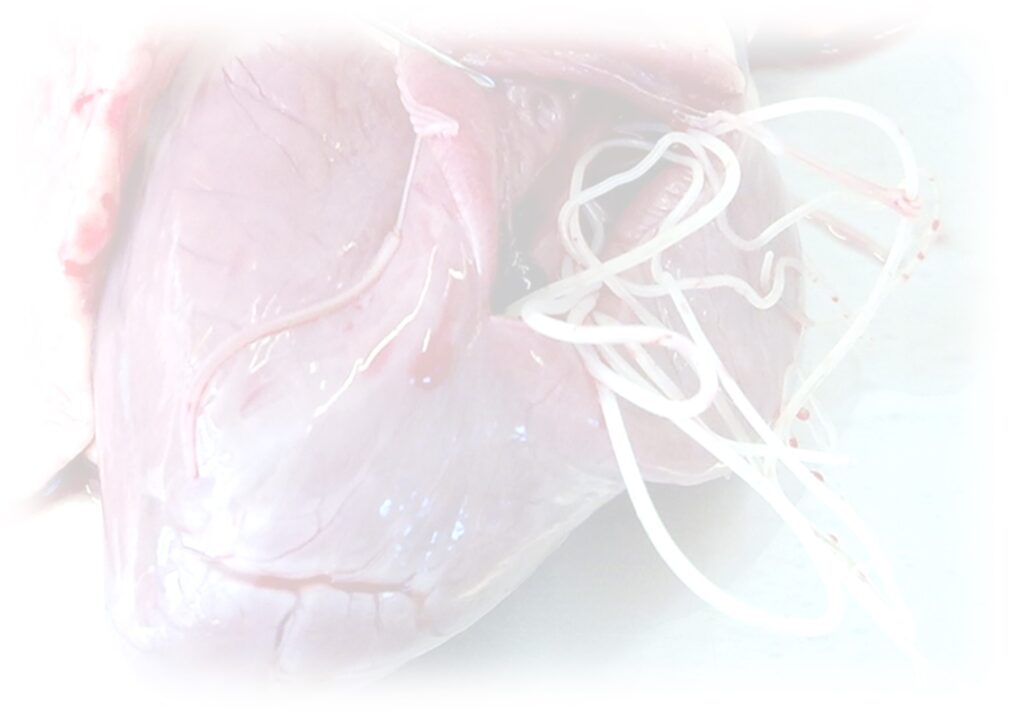Photo Credit: https://journals.asm.org/doi/10.1128/CMR.00012-12
Canine heartworm disease is a potentially deadly disease caused by the worm Dirofilaria immitis. This parasitic worm lives in the heart and lungs (pulmonary arteries) of an infected dog. The worm travels through the bloodstream, harming arteries and vital organs as they go. Ultimately, it completes its journey to the vessels of the lung and the heart chamber about six months after the initial infection. Several hundred worms can live in one dog for as long as five to seven years. Dogs are natural hosts for heartworm infection however, other animals can be infected such as cats, ferrets and even humans (though it has not been recognized to be a major health issue). The disease is fatal but also preventable.
TRANSMISSION OF HEARTWORM DISEASE
- The source of this disease is a mosquito bite transmitting larvae of the worm Dirofilaria immitis. It has been reported that there are at least 70 species of mosquitoes that can transmit the disease including Aedes, Anopheles and Mansonia species. Humans and other mammals are accidental hosts of the worm. You do not get infected by having contact with your pet.
- An animal must carry at least two heartworms (a male and a female) in order for female heartworms to reproduce.
- Females produce “babies” called “microfilaria” which are shed into an animal’s bloodstream but are not capable of directly causing the heartworm disease as they need further development in the mosquito. The microfilariae must be taken up by biting mosquitoes and get transformed into infective larvae over a two-week period inside the mosquito.
- When a mosquito next bites a susceptible animal, the infective larvae enter the tissues and begin a migration into the blood vessels.
- Heartworms enter an animal’s bloodstream as tiny, invisible larvae, but can reach lengths of more than twelve inches at maturity.
SIGNS AND SYMPTOMS
Severity of signs is dependent on the worm load, the immune status of the animal and the duration of the infection. Some dogs exhibit no symptoms at all until late stages of infection while others may show signs such as: labored breathing, coughing, vomiting, weight loss, listlessness, and fatigue after even a moderate exercise.
DIAGNOSIS AND TREATMENT
Heartworm disease is diagnosed by examination, radiographs or ultrasound, and a blood test. After diagnosis, a thorough examination of the infected dog should be conducted to evaluate the best course of treatment and the potential risks involved. There are various drugs, both topical and intravenous to cater for the infection. All treatment protocols will require at least several weeks of exercise restriction during and after treatment. All dogs should be routinely screened with a blood test for heartworm either annually or before being placed on a new prescription for the prevention of heartworm.
PREVENTING HEARTWORM
Heartworm is easily preventable with an inexpensive, chewable pill or topical medication available at a vet’s prescription. The drugs are usually administered monthly and can be given to dogs under 6 months of age without a blood test. Older animals must be screened for the disease prior to starting medication. Keep your dog on preventive medication all year long. Many of these medications also prevent other intestinal parasites. The use of adulticides to also kill adult mosquitoes that spread and transmit these worms is also recommended. If you notice that your dog’s energy has decreased, he seems ill, or he’s exhibiting any of the general symptoms described above, contact your veterinarian immediately.

